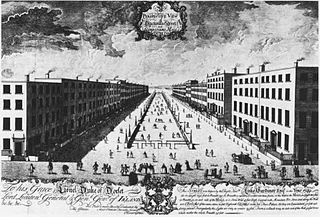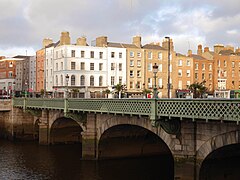
The Wide Streets Commission was established by an Act of Parliament in 1758, at the request of Dublin Corporation, as a body to govern standards on the layout of streets, bridges, buildings and other architectural considerations in Dublin. The commission was abolished by the Dublin Improvement Act of 1849, with the final meeting of the Commission taking place on 2 January 1851.

The Talbot Memorial Bridge is a road bridge spanning the River Liffey in Dublin, Ireland. Completed in 1978, it is 22 metres (72 feet) wide, and was designed by De Leuw, Chadwick and O’hEocha Consulting Engineers. The bridge marks the furthest point up to the Liffey to which tall ships may travel, as all bridges downriver of it are either swingbridges or bascule.

O'Connell Bridge is a road bridge spanning the River Liffey in Dublin, Ireland, which joins O'Connell Street to D'Olier Street, Westmoreland Street and the south quays.

The Millennium Bridge is a pedestrian bridge spanning the River Liffey in Dublin, Ireland, joining Eustace Street in Temple Bar to the north quays.

O'Donovan Rossa Bridge is a road bridge spanning the River Liffey in Dublin, Ireland, which joins Winetavern Street to Chancery Place and the north quays.

The Loopline Bridge is a railway bridge spanning the River Liffey and several streets in Dublin, Ireland. It joins rail services from south of Dublin to Connolly Station and lines north.

Seán O'Casey Bridge is a pedestrian swingbridge spanning the River Liffey in Dublin, Ireland, joining City Quay in the Grand Canal Docks area to North Wall Quay and the IFSC.

Frank Sherwin Bridge is a road bridge spanning the River Liffey in Dublin, Ireland. It joins St. John's Road and the south quays from Heuston Station to Wolfe Tone Quay and Parkgate Street on the Northside.

The Butt Bridge is a road bridge in Dublin, Ireland which spans the River Liffey and joins Georges Quay to Beresford Place and the north quays at Liberty Hall.

Mellows Bridge is a road bridge spanning the River Liffey, in Dublin, Ireland and joining Queen Street and Arran Quay to the south quays.

Father Mathew Bridge is a road bridge spanning the River Liffey in Dublin, Ireland, which joins Merchants Quay to Church Street and the north quays. It occupies the approximate site of the original, and for many years the only, Bridge of Dublin, dating back to the 11th century.

Lucan Bridge is a road bridge spanning the River Liffey in Lucan, County Dublin, Ireland. It joins Lucan's Main Street to the Lower Lucan Road, carrying traffic towards Clonsilla and the north, and the Strawberry Beds to the east. Designed by George Knowles, it was built in 1814. Constructed in collaboration with James Savage at a cost of more than £9,000, it replaced several previous bridges which had been carried away by floods.

Island Bridge, formerly Sarah or Sarah's Bridge, is a road bridge spanning the River Liffey, in Dublin, Ireland which joins the South Circular Road to Conyngham Road at the Phoenix Park.

Samuel Beckett Bridge is a cable-stayed swingbridge in Dublin, Ireland that joins Sir John Rogerson's Quay on the south side of the River Liffey to Guild Street and North Wall Quay in the Docklands area.
George Semple was a notable Irish builder and architect.

Rory O'More Bridge is a road bridge spanning the River Liffey in Dublin, Ireland and joining Watling Street to Ellis Street and the north quays.

Humphrey Jervis (1630–1707) was one of the first notable private developers in the history of Dublin.

The Custom House was a large brick and limestone building located at present day Wellington Quay in Dublin, Ireland which operated as a custom house, hosting officials overseeing the functions associated with the import and export of goods to Dublin from 1707 until 1791. It also served as the headquarters of the Revenue Commissioners, as a meeting place and offices for the Wide Streets Commission and was said to be Dublin's first dedicated office building.



























